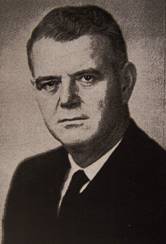
CALLIS H. ATKINS
THE THIRD CHIEF ENGINEER OF THE USPHS COMMISSIONED CORPS
Chief Engineer: 1962-1966
Callis Harvy Atkins, born in White Plains, North Carolina in June 1910, was known to his friends and colleagues as “Slim.” His career was exemplified by national and international contributions to the field of environmental engineering and to the inclusion of environmental health as a major component of public heath progress.
He received a bachelor degree in civil engineering from the University of North Carolina in 1933, where he also took graduate courses as well as at Harvard University. He began his working career as a field engineer with the North Carolina State Health department prior to joining the Commissioned Corps of the Public Health Service in 1936. His service in the Corps was to extend 30 years through 1966.
After serving in a variety of environmental programs throughout the United States, “Slim” spent three years (1952-1955) on assignment to the United States Technical Cooperation Mission to India as an advisor in public health engineering for the government of India recruiting and training engineers to develop and deliver clean water and he worked on malaria prevention. During the later portions of his PHS career, while in the Bureau of State Services, he served as Regional Engineer for the Midwestern States, and later as Regional Engineer for the Mid-Atlantic States.
Callis Harvy Atkins was elevated to the rank of Rear Admiral (RADM) with the corresponding titles of Chief Engineer and Assistant Surgeon General in 1962, a post he held until his retirement from the Public Health Service in 1966. The nomination for his Distinguished Service Medal, which he received in September 1966, states, “He demonstrated unusual ability at maintaining effective working relationships with state health departments, developing workable programs, for water pollution control agencies, and schools of engineering and public health on major aspects of environmental health.”
When RADM Atkins retired from the PHS, he accepted the position of Director of the Division of Environmental Health for the World Health Organization in Geneva, Switzerland. His work there through 1971, included the establishment of international, regional and national reference centers to support research and development in environmental health and provide exchange points for environmental information. A part of that effort was the establishment of a sanitary engineering center in Rabat, Morocco to train personnel for global health service in French-speaking countries.
In 1971 upon his retirement from the WHO, “Slim” moved to a farm in Albemarle County, Virginia where he continued his contributions to public health and engineering organizations. In 1984 he established a model hydroelectric facility to demonstrate the value of individual non polluting energy systems to power rural homes. He also served on the Virginia Solid Waste Commission.
Callis H. Atkins was a charter member of the Inter-American Society of Sanitary Engineering, a member of the American Society of Sanitary Engineering, a member of the American Public Health Association, the American Water Works Association, the Water Pollution Control Federation, the Conference of State Sanitary Engineers and the Conference of Federal Sanitary Engineers. He was also a Diplomate in the American Academy of Environmental Engineering, a Fellow in the American Society of Civil Engineers, a member of the National Society of Professional Engineers and a registered Professional Engineer in the District of Columbia and Virginia.
RADM Atkins was a recipient of the Public Health Service’s Distinguished Service Medal and the Walter Snyder Award from the National Sanitation Foundation. He passed away in December 1996 at age 86. At his death he was survived by his wife, Josephine and two daughters, Margaret McGovern and Mary Jo Ayers. A fellowship in environmental engineering honors his name at his Alma Mater, the University of North Carolina.
Page Last Modified on 1/9/2025